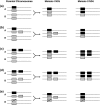Implications of copy number variation in people with chromosomal abnormalities: potential for greater variation in copy number state may contribute to variability of phenotype
- PMID: 22132061
- PMCID: PMC3051043
- DOI: 10.1007/s11568-010-9144-z
Implications of copy number variation in people with chromosomal abnormalities: potential for greater variation in copy number state may contribute to variability of phenotype
Abstract
Copy number variation is common in the human genome with many regions, overlapping thousands of genes, now known to be deleted or amplified. Aneuploidies and other forms of chromosomal imbalance have a wide range of adverse phenotypes and are a common cause of birth defects resulting in significant morbidity and mortality. "Normal" copy number variants (CNVs) embedded within the regions of chromosome imbalance may affect the clinical outcomes by altering the local copy number of important genes or regulatory regions: this could alleviate or exacerbate certain phenotypes. In this way CNVs may contribute to the clinical variability seen in many disorders caused by chromosomal abnormalities, such as the congenital heart defects (CHD) seen in ~40% of Down's syndrome (DS) patients. Investigation of CNVs may therefore help to pinpoint critical genes or regulatory elements, elucidating the molecular mechanisms underlying these conditions, also shedding light on the aetiology of such phenotypes in people without major chromosome imbalances, and ultimately leading to their improved detection and treatment.
Keywords: Aneuploidy; Chromosomal abnormalities; Copy number variation; Phenotypic variability.
Figures


Similar articles
-
Identification of De Novo and Rare Inherited Copy Number Variants in Children with Syndromic Congenital Heart Defects.Pediatr Cardiol. 2018 Jun;39(5):924-940. doi: 10.1007/s00246-018-1842-7. Epub 2018 Mar 14. Pediatr Cardiol. 2018. PMID: 29541814
-
Clinical and genetic findings in patients with congenital cataract and heart diseases.Orphanet J Rare Dis. 2021 May 31;16(1):242. doi: 10.1186/s13023-021-01873-7. Orphanet J Rare Dis. 2021. PMID: 34059112 Free PMC article.
-
[Association of fetal cardiac structural abnormalities and chromosomal aneuploidies and copy number variations].Zhonghua Yi Xue Yi Chuan Xue Za Zhi. 2021 Aug 10;38(8):795-797. doi: 10.3760/cma.j.cn511374-20200609-00421. Zhonghua Yi Xue Yi Chuan Xue Za Zhi. 2021. PMID: 34365628 Chinese.
-
Chromosome copy number variants in fetuses with syndromic malformations.Birth Defects Res. 2017 Jun 1;109(10):725-733. doi: 10.1002/bdr2.1054. Birth Defects Res. 2017. PMID: 28568742 Review.
-
Mouse models of aneuploidy.ScientificWorldJournal. 2012;2012:214078. doi: 10.1100/2012/214078. Epub 2012 Jan 3. ScientificWorldJournal. 2012. PMID: 22262951 Free PMC article. Review.
Cited by
-
A familial Cri-du-Chat/5p deletion syndrome resulted from rare maternal complex chromosomal rearrangements (CCRs) and/or possible chromosome 5p chromothripsis.PLoS One. 2013 Oct 15;8(10):e76985. doi: 10.1371/journal.pone.0076985. eCollection 2013. PLoS One. 2013. PMID: 24143197 Free PMC article.
-
Importance of determining variations in the number of copies in newborns with autosomal aneuploidies.Biomedica. 2021 Jun 29;41(2):282-292. doi: 10.7705/biomedica.5354. Biomedica. 2021. PMID: 34214269 Free PMC article. English, Spanish.
-
The complex SNP and CNV genetic architecture of the increased risk of congenital heart defects in Down syndrome.Genome Res. 2013 Sep;23(9):1410-21. doi: 10.1101/gr.147991.112. Epub 2013 Jun 19. Genome Res. 2013. PMID: 23783273 Free PMC article.
-
Integrated analysis of the critical region 5p15.3-p15.2 associated with cri-du-chat syndrome.Genet Mol Biol. 2019;42(1 suppl 1):186-196. doi: 10.1590/1678-4685-GMB-2018-0173. Epub 2019 Apr 11. Genet Mol Biol. 2019. PMID: 30985858 Free PMC article.
-
Identifying the risk of producing aneuploids using meiotic recombination genes as biomarkers: A copy number variation approach.Indian J Med Res. 2017 Jan;145(1):39-50. doi: 10.4103/ijmr.IJMR_965_14. Indian J Med Res. 2017. PMID: 28574013 Free PMC article.
References
-
- Botto LD, May K, Fernhoff PM, Correa A, Coleman K, Rasmussen SA, Merritt RK, O’Leary LA, Wong LY, Elixson EM, et al. A population-based study of the 22q11.2 deletion: phenotype, incidence, and contribution to major birth defects in the population. Pediatrics. 2003;112:101–107. doi: 10.1542/peds.112.1.101. - DOI - PubMed
LinkOut - more resources
Full Text Sources

